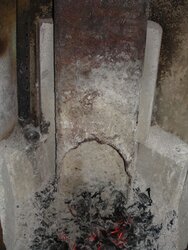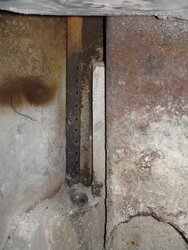The other day, it was warm enough here to let the fire burn out and do a little stove maintenance.
Since I'd already roughed out an idea for it, I also took the opportunity to install an improved supplemental air supply in my old cylindrical parlor stove. (Despite the risk of a semantics war, I'm going to refer to the supplemental air as 'secondary'.)
As described in other threads, I've modified the stove in other ways previously, but the most relevant point to remember is that there is an internal baffle in the stove which opens about 8" from the firebox floor... and through which most/all exhaust from the stove must pass before entering the actual flue and passing out of the stove. Among other things, this means coals can be mounded up near the baffle entry, and everything leaving the firebox must first pass in close proximity to the coals... which are at a temperature near (or well over) 1100*... sufficient for secondary combustion to occur.
The new supplemental supply tube feeds air through a number of drilled 3/16" holes from about 9" to 16" above the firebox floor (and very close to the baffle entry) to take advantage of the heat near the coals... a quite different 'delivery point' for the secondary air than most EPA stoves.
The results are (of course) more noticeable with a hot fire and a good coal bed. When other manual stove drafts are closed, the fire continues to burn on the secondary air alone. And internal flue and stovetop temps either stabilize or climb somewhat when the other contols are closed... when before (with a smaller diameter supply tube) they would generally stabilize or fall.
So far, I haven't made any effort to regulate the secondary flow... and today being cold and windy, the stove is running pretty hot (even clamped down fairly tight). I may end up having to screen the external orifice that feeds the tube... to limit flow somewhat.
Both yesterday and today have seen multiple burns with what gives every indication of being sustained secondary combustion... an hour and a half to two hours of elevated temps and audible flame ignition (remember, I can't see the fire) after reload - with all other stove drafts closed, and my flue damper about half open.
To drive home the point, I'm all but convinced that the cheap 1" thick catalyst in the top of the stove no longer has much effect but that of draft reduction... no temperature boost is seen on engagement anymore... yet the stovetop internal temps during a secondary burn are still running 800-1000* and the flue (at 12" above stovetop) 500-600*.
Now to replace the catalyst...
(And it occurs to me that it might be worth my while to ask for help fabricating a glass door for this thing.)
Peter B.
-----
Since I'd already roughed out an idea for it, I also took the opportunity to install an improved supplemental air supply in my old cylindrical parlor stove. (Despite the risk of a semantics war, I'm going to refer to the supplemental air as 'secondary'.)
As described in other threads, I've modified the stove in other ways previously, but the most relevant point to remember is that there is an internal baffle in the stove which opens about 8" from the firebox floor... and through which most/all exhaust from the stove must pass before entering the actual flue and passing out of the stove. Among other things, this means coals can be mounded up near the baffle entry, and everything leaving the firebox must first pass in close proximity to the coals... which are at a temperature near (or well over) 1100*... sufficient for secondary combustion to occur.
The new supplemental supply tube feeds air through a number of drilled 3/16" holes from about 9" to 16" above the firebox floor (and very close to the baffle entry) to take advantage of the heat near the coals... a quite different 'delivery point' for the secondary air than most EPA stoves.
The results are (of course) more noticeable with a hot fire and a good coal bed. When other manual stove drafts are closed, the fire continues to burn on the secondary air alone. And internal flue and stovetop temps either stabilize or climb somewhat when the other contols are closed... when before (with a smaller diameter supply tube) they would generally stabilize or fall.
So far, I haven't made any effort to regulate the secondary flow... and today being cold and windy, the stove is running pretty hot (even clamped down fairly tight). I may end up having to screen the external orifice that feeds the tube... to limit flow somewhat.
Both yesterday and today have seen multiple burns with what gives every indication of being sustained secondary combustion... an hour and a half to two hours of elevated temps and audible flame ignition (remember, I can't see the fire) after reload - with all other stove drafts closed, and my flue damper about half open.
To drive home the point, I'm all but convinced that the cheap 1" thick catalyst in the top of the stove no longer has much effect but that of draft reduction... no temperature boost is seen on engagement anymore... yet the stovetop internal temps during a secondary burn are still running 800-1000* and the flue (at 12" above stovetop) 500-600*.
Now to replace the catalyst...
(And it occurs to me that it might be worth my while to ask for help fabricating a glass door for this thing.)
Peter B.
-----


 )
)
